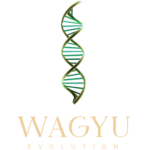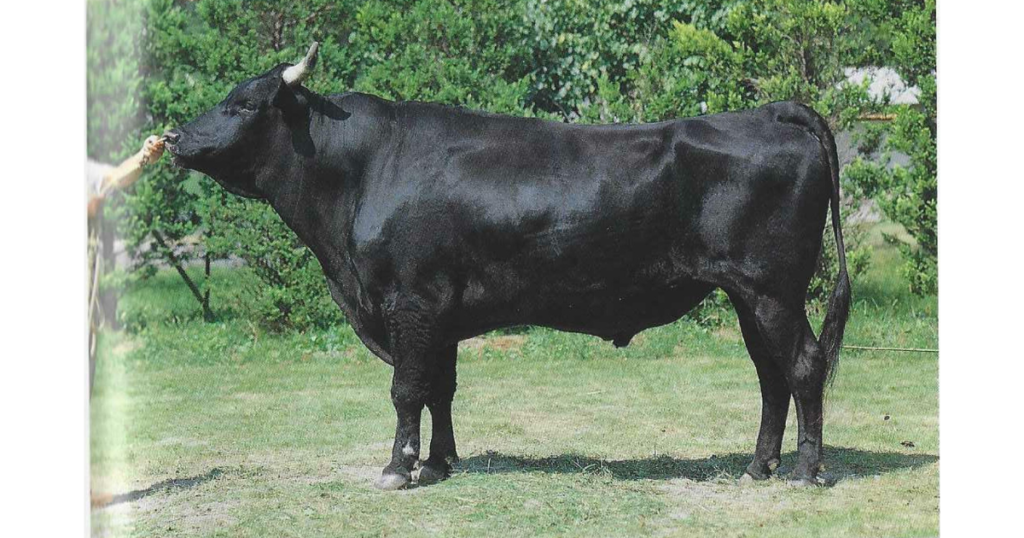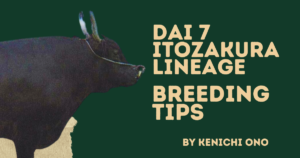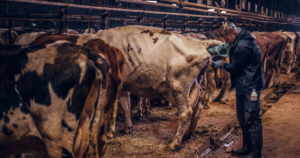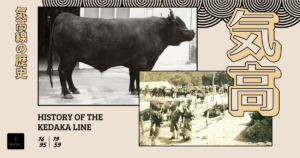Monjiro: The Elite Hyogo Bull
Table of Contents
* Note: This is not a direct translation of Kenichi Ono’s “Top 100 Famous Beef of Japan [Revised Edition]” but a summary that was written using it as a direct source.
Early Life
Monjiro, a sire bull owned by the Livestock Improvement Association that left an unshakable legacy, was born on March 15, 1981 at the residence of Mr. Ichikazu Teratani in Onsen Town, Hyogo Prefecture.
His father was Amidoi, who was 10 years old and in his prime at the time, and his maternal grandfather was Tamoridoi, renowned for producing the distinguished mother line that gave birth to Anyadoi. Monjiro is recorded as the 11th offspring, born late in the life of his mother, Harumi.
After being raised and trained by Mr. Michio Inoue, Monjiro was presented as the representative of Hyogo Prefecture at the Fukushima National Competition in 1982 (Showa 57), where he won 2nd place in the premium category and was auctioned off for 16 million yen to the Livestock Improvement Association. Originally, the name “Monjiro” was intended to be decided by public submission, but considering that he would be used at the Maebashi Sire Bull Center, he was named “Monjiro” (his childhood name was Harutoshi 2). The name had a strong impact, and as a result of its active use as a sire bull for dairy farmers mainly in Gunma Prefecture, Monjiro’s performance in the field was soon recognized, leading to his national fame spreading rapidly.
Although Monjiro was mainly used for F1 breeding, the indirect test results showed a daily gain (DG) of 0.87 kg, ribeye area of 44 cm², and marbling score of +3.3 (old standard), which were not particularly impressive. However, the publication of sales data from F1 progeny in the field propelled Monjiro from Maebashi to nationwide recognition. According to the nationwide beef cattle carcass quality survey conducted around 1990 (Heisei 2), Monjiro ranked 4th in sales price and 7th in revenue among 165 tested sire bulls, achieving results comparable to those of the then-popular Shigeharu and Yasufuku.
Monjiro was used as a sire bull for over 12 years, from 1983 until 1994, and in his later years, he supported the foundation of the Livestock Improvement Association. He passed away on December 23, 1994, at the age of 13 years and 9 months. It is estimated that nearly 400,000 straws of semen were produced, demonstrating the significant role that a single sire bull like Monjiro had played in the improvement of Japanese Wagyu cattle.
Features
Strengths: Meat color, fine texture, strong genetic influence, high reproductive ability as a breeding cow, fat quality.
Weaknesses: Shoulder thickness, ribeye size, adaptability to group feeding, depth, growth capacity.
The distinctive physical characteristics of Monjiro include slightly thin shoulders, a lack of depth in the lower limbs, and the presence of white-tipped horns in many of the cattle. In terms of genetics, Monjiro often strongly exhibits the features of both Amidoi and Tamoridoi, with many of his female offspring being typical of the refined Hyogo line.
On November 1, 1996, at the National Beef Carcass Competition held at the Tokyo Meat Market, a cow bred in Sado, Niigata, from the combination of Koue × Monjiro × Kotobuki (5th generation) won the prestigious first-place award, marking the first time Niigata Prefecture received this national honor.
Additionally, the second-generation Monjiro offspring, with Hokugoku 7-8 as their sire, have shown exceptional stability in their growth performance, receiving high praise at calf markets across the country.
Pedigree Background
Monjiro’s sire, Amidoi, has become a distinguished bull. Amidoi is now considered a foundational sire in the Japanese Wagyu breed. Besides Monjiro, Amidoi has sired many notable offspring, including Anyadoi, Dai-2 Ankadodoi, Anyukidoi, Amikane, Tanimi, Bifuku (Hokkaido), Kaneyama (Fukushima), Kosukumi, Yasuharu (Nagasaki), Yaefuku (Oita), Antaka, Ippuku, Hideyasu (Miyazaki), Koushisa, Teruzakura, Tajimafuku, Choufuku (Kagoshima), Anpadodoi, Fukumimi (Okinawa), among others. These bulls have become representatives of various regions across Japan, and their descendants continue to thrive.
His maternal grandfather, Tamoridoi, is known for his excellent meat quality and has been prominently active as a maternal line for a long time. He is a behind-the-scenes, renowned bull, known as the maternal grandfather of prominent bulls. Additionally, the great-grandfather Suzuyukidoi is known as the sire of the famous bull Tochinishiki, which was used in Akita Prefecture.
Major Successor Bulls
Successor bulls of Monjiro are being developed nationwide, primarily by the Livestock Improvement Association, and recently, bulls with abilities similar to their sire have begun to be used.
- Otojirou (Livestock Improvement Association, Morioka)
Born May 21, 1992 (Heisei 4). Grandfather is Otomotsuru 19. Indirect test results: Daily Gain (DG) 0.86 kg, Beef Marbling Score (BMS) 2.4, Ribeye area 46 cm². In the 1996 indirect test by the Livestock Improvement Association, he ranked 2nd after Mitsufuku and is a highly anticipated sire bull. He closely resembles the young Monjiro, and his performance was consistent with good growth.
- Anjirou (Livestock Improvement Association, Morioka)
Born April 1, 1993 (Heisei 5). Grandfather is Kikuteroid, great-grandfather is Amidoi. Indirect test results: DG 0.92 kg, BMS 2.2, Ribeye area 46 cm². The maternal line is also strong, and the growth of the test animals was smooth, raising expectations for performance surpassing Otojirou.
In addition to these, Kikutou (grandfather Itotou) from Okayama Prefecture and Itojirou from Yamaguchi Prefecture should also be noted as bulls to watch in the future.
Breeding Considerations & Recommendations
Recommmended Lines to Pair
Monjiro’s weaknesses are shoulder width and depth, so it is fundamental to select mating partners with these points in mind. Suitable partners include Hokugoku 7-8, Itohana (Shimane), Dai-5 Natsufuji (Iwate), Hiramokatsu (Kagoshima), and Fukuou (Miyazaki), among others from Shimane and Tottori. It is fundamental to select cattle with thick shoulder width for mating.
Monjiro is a bull with very few occurrences of defects or weak offspring. However, inbreeding with the Hyogo line can sometimes lead to a noticeable decrease in growth rate. Therefore, it’s recommended to be very cautious of the inbreeding coefficient and avoid reckless crossings.
References
小野健一. 日本名牛百選〔改訂版〕(pp.77-84). 肉牛新報社.
